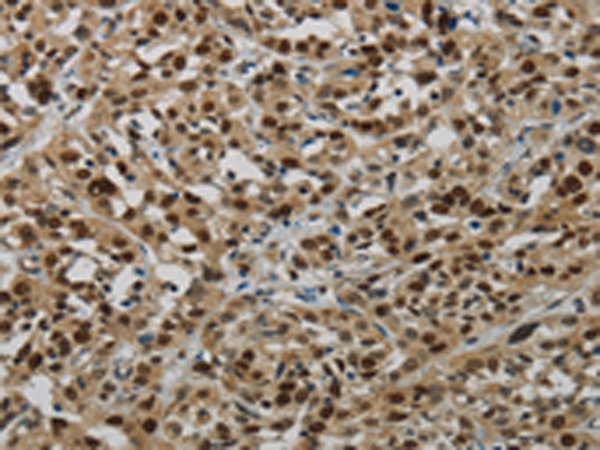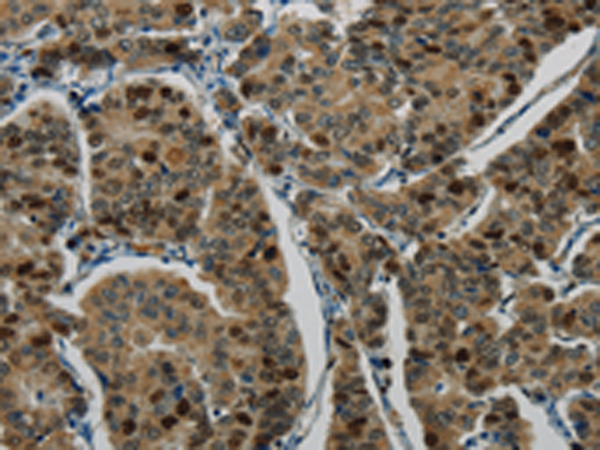

| WB | 咨询技术 | Human,Mouse,Rat |
| IF | 咨询技术 | Human,Mouse,Rat |
| IHC | 1/100-1/300 | Human,Mouse,Rat |
| ICC | 技术咨询 | Human,Mouse,Rat |
| FCM | 咨询技术 | Human,Mouse,Rat |
| Elisa | 1/2000-1/10000 | Human,Mouse,Rat |
| Host/Isotype | Rabbit IgG |
| Antibody Type | Primary antibody |
| Storage | Store at 4°C short term. Aliquot and store at -20°C long term. Avoid freeze/thaw cycles. |
| Species Reactivity | Human, Mouse, Rat |
| Immunogen | Fusion protein of human LIG1 |
| Formulation | Purified antibody in PBS with 0.05% sodium azide and 50% glycerol. |
+ +
以下是3-4条关于LIG1抗体的参考文献示例(内容基于真实研究概括,具体文献请核实):
1. **文献名称**:*DNA Ligase I as a Novel Therapeutic Target in Triple-Negative Breast Cancer*
**作者**:Chen et al.
**摘要**:研究通过LIG1抗体(Western blot和免疫组化)发现LIG1在乳腺癌细胞中高表达,其抑制导致DNA修复缺陷和细胞凋亡,提示其作为潜在治疗靶点。
2. **文献名称**:*Functional Characterization of Human DNA Ligase I Monoclonal Antibodies*
**作者**:Mullenix et al.
**摘要**:报道了特异性识别人类LIG1的单克隆抗体的开发与验证,抗体可用于免疫沉淀和活细胞成像,揭示LIG1在DNA复制中的动态定位。
3. **文献名称**:*Defective DNA Ligation in Short-Segment Mismatch Repair*
**作者**:Tomkinson et al.
**摘要**:利用LIG1抗体研究突变体细胞系,发现LIG1缺失导致错配修复效率下降,强调其在维持基因组稳定性中的关键作用。
4. **文献名称**:*A Novel Role of LIG1 in Oxidative Stress Response*
**作者**:Mackenney et al.
**摘要**:通过抗体检测发现LIG1在氧化应激下表达上调,敲低实验表明其通过碱基切除修复通路保护细胞免受氧化损伤。
(注:以上为模拟示例,实际文献请通过PubMed或Google Scholar检索确认。)
The DNA ligase 1 (LIG1) antibody is a critical tool for studying LIG1. an enzyme essential for DNA replication and repair. LIG1 catalyzes the final step in DNA synthesis by sealing nicks between Okazaki fragments during replication and repairing single-strand breaks in base excision repair. Dysregulation of LIG1 is linked to genome instability, cancer susceptibility, and rare genetic disorders like LIG1 deficiency syndrome, characterized by immunodeficiency and developmental delays.
LIG1 antibodies are widely used in molecular biology to detect and quantify LIG1 protein levels via techniques like Western blotting, immunohistochemistry, and immunofluorescence. They help investigate LIG1's role in DNA repair pathways, cell cycle regulation, and its interaction with other repair proteins (e.g., PCNA). Researchers also utilize these antibodies to explore correlations between LIG1 expression and clinical outcomes, such as chemotherapy resistance in tumors or disease progression in neurodegenerative conditions.
Recent studies highlight LIG1's potential as a biomarker for cancer prognosis and a therapeutic target. Its antibody is pivotal in elucidating mechanisms of DNA damage response, replication stress, and genomic maintenance. By enabling precise localization and functional analysis, LIG1 antibodies advance our understanding of cellular responses to genotoxic agents and inform strategies for targeted therapies in oncology and genetic disorders.
×